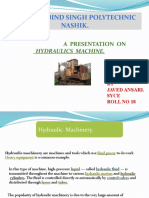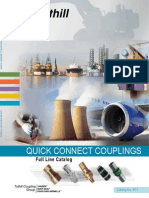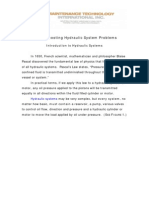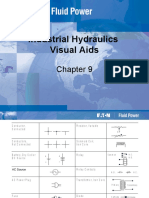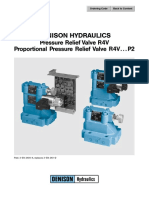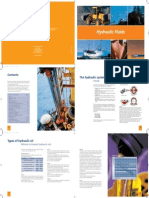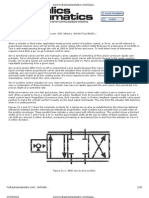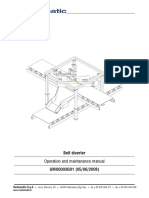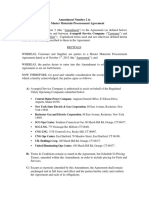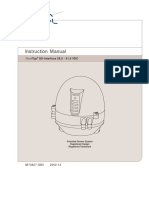0 ratings0% found this document useful (0 votes)
206 viewsProportional and Servovalves
Proportional and Servovalves
Uploaded by
Marius IsdrailaProportional and servovalves can infinitely vary flow through directional control valves. Servovalves precisely control flow but require very clean fluid, while proportional valves provide less precise control but are more tolerant of contamination. Infinitely variable valves allow actuators to precisely control speed, position, and force. Proportional valves use feedback transducers and electronics to control spool position and flow, enabling smooth acceleration and deceleration of actuators. The addition of a pressure compensator helps maintain constant flow despite pressure fluctuations.
Copyright:
© All Rights Reserved
Available Formats
Download as DOCX, PDF, TXT or read online from Scribd
Proportional and Servovalves
Proportional and Servovalves
Uploaded by
Marius Isdraila0 ratings0% found this document useful (0 votes)
206 views14 pagesProportional and servovalves can infinitely vary flow through directional control valves. Servovalves precisely control flow but require very clean fluid, while proportional valves provide less precise control but are more tolerant of contamination. Infinitely variable valves allow actuators to precisely control speed, position, and force. Proportional valves use feedback transducers and electronics to control spool position and flow, enabling smooth acceleration and deceleration of actuators. The addition of a pressure compensator helps maintain constant flow despite pressure fluctuations.
Original Description:
Rexroth training
Copyright
© © All Rights Reserved
Available Formats
DOCX, PDF, TXT or read online from Scribd
Share this document
Did you find this document useful?
Is this content inappropriate?
Proportional and servovalves can infinitely vary flow through directional control valves. Servovalves precisely control flow but require very clean fluid, while proportional valves provide less precise control but are more tolerant of contamination. Infinitely variable valves allow actuators to precisely control speed, position, and force. Proportional valves use feedback transducers and electronics to control spool position and flow, enabling smooth acceleration and deceleration of actuators. The addition of a pressure compensator helps maintain constant flow despite pressure fluctuations.
Copyright:
© All Rights Reserved
Available Formats
Download as DOCX, PDF, TXT or read online from Scribd
Download as docx, pdf, or txt
0 ratings0% found this document useful (0 votes)
206 views14 pagesProportional and Servovalves
Proportional and Servovalves
Uploaded by
Marius IsdrailaProportional and servovalves can infinitely vary flow through directional control valves. Servovalves precisely control flow but require very clean fluid, while proportional valves provide less precise control but are more tolerant of contamination. Infinitely variable valves allow actuators to precisely control speed, position, and force. Proportional valves use feedback transducers and electronics to control spool position and flow, enabling smooth acceleration and deceleration of actuators. The addition of a pressure compensator helps maintain constant flow despite pressure fluctuations.
Copyright:
© All Rights Reserved
Available Formats
Download as DOCX, PDF, TXT or read online from Scribd
Download as docx, pdf, or txt
You are on page 1of 14
Proportional and servovalves
Infinitely variable directional control valves
The directional control valves discussed so far in this series have all been configured to either pass
full flow or completely block flow. The only way to decrease flow through these valves is by adding
flow controls or by mechanically limiting movement of an internal part.
The first infinitely variable valve available was the servovalve. Internal flow-modifying parts could be
moved to any position at any rate, so output from any port could be varied at will. (Some call these
valves infinitely variable 4-way flow controls.) The main problem with servovalves was (and still is)
that they require very clean fluid to keep them operating effectively. Fluid from a standard well-
maintained hydraulic circuit contains enough contamination to cause most servovalves to fail in a
matter of minutes or only last a few hours at best. This meant that the original servovalves were tried
and removed from many machines that needed precise control but not at the perceived cost of
cleaning up the hydraulic oil.
Why use infinitely variable valves?
Some actuators must move at a precise speed, stop at a close-tolerance position, or produce a very
accurate force to perform the work for which they were designed. With the proper input signals and
feedback devices, proportional or servovalves can make an actuator perform any or all these
functions flawlessly.
Rolling mills turn out sheet consistently to a tolerance of 0.0005 in. at sheet speeds of 2000 to 5000
feet per minute. Hydraulic cylinders controlled by servovalves maintain the proper force and position
the rolls precisely from feedback signals sent by sensors that measure metal thickness, cylinder
force, and position. Airline pilots train in simulators moved by hydraulic cylinders so precisely that the
pilots get the feel of landing gear raising and locking in position. Even entertainment rides use
servovalves to make passengers think they are in 20-ft waves when they are actually in an enclosed
articulated room in a shopping mall.
For less precise movement, there are proportional valves that mimic the output of servovalves but
respond more slowly. They are less expensive than servovalves and more contamination tolerant, so
they have replaced cam valves and other mechanical devices used to get smooth motions.
Hydraulic proportional directional control valves
The symbol and cutaway view in Figure 12-1 represent a direct-acting proportional valve that
handles flows as high as 10 to 30 gpm in D03- or D05-size valve interfaces. Proportional valves use
the same interface standards as NFPA and ISO directional valves so they can be installed in a
circuit without having to change the piping.
Fig. 12-1. Direct-acting proportional valve
Physically, proportional valves appear the same as their on/off solenoid counterparts. The big
difference is in the way their solenoid coils perform. Proportional coils operate on DC current and
produce varying force with varying voltage. The symbol shows the solenoid slash in the operator box
with a sloping arrow through the slash. This indicates the solenoid has variable force that moves the
spool more or less as voltage increases and falls. The other indication on the symbol that shows the
spool is infinitely variable is the parallel lines down both sides of the boxes. Proportional valves
operate similarly to manual valves, but they use electronics instead of hand power.
To eliminate flow lag from spool overlap, most manufacturers cut vee notches or use some similar
method that allows some flow to pass as soon as the spool moves. Vee notches also give smooth
flow buildup until the spool moves through the land overlap.
Proportional valves only have two center configurations (as shown by the symbols in Figure 12-1).
This means that pressure-compensated pumps with accumulators normally power circuits with
proportional valves. The circuits are pressurized at all times to produce fast response from an
actuator when motion is called for. (A pressure-compensated circuit also wastes the least amount of
energy when throttling flow.)
The valve in Figure 12-1 depends on a certain voltage to move the spool a certain distance to pass
a certain flow. This works reasonably well, but is not accurate over a broad range of pressures,
flows, and temperatures. Most valves of this design are used to smoothly accelerate and/or
decelerate an actuator. The spool is electronically controlled to shift over a period of time to increase
flow at a controlled rate. Spool-shift speed can be controlled electronically as it opens and closes to
give smooth acceleration and deceleration. Spool-shift distance can also be limited electronically to
set a maximum speed when required.
Fig. 12-2. Direct-acting proportional directional control
valve with spool-position feedback transducer
To give better spool control, a linear variable-displacement transducer (LVDT) is added to the basic
valve. The cutaway view and symbol in Figure 12-2 represent a direct-acting valve with an LVDT.
Feedback from the LVDT tells the electronic controller the spools position and makes sure it goes to
the same place when it receives the same signal. With this arrangement, the spool always shifts to
an exact location and opens the same size orifice so it can pass the same flow when pressure drop
and viscosity stay the same. Control of flow is more accurate with an LVDT but pressure drop does
not stay constant and viscosity often changes throughout the day so speed variations are still
apparent. Such flow variations caused by system pressure fluctuation can almost be eliminated by
the addition of a hydrostat module in port P as shown in Figure 12-3.
Fig. 12-3. Direct-acting proportional directional control
valve with LVDT and pressure-compensating hydrostat
module
A hydrostat is simply a pressure-reducing valve set to hold downstream pressure in a 100- to 150-
psi range. However, a hydrostat has a pilot line from a shuttle valve that reads downstream pressure
at ports A and B, then feeds it back to the bias-spring end of the spool that controls the 100 to 150
psi. The function of a hydrostat is to maintain a constant pressure drop across the spool orifice so
flow stays constant regardless of changes in system pressure. (For a thorough understanding of how
pressure compensation works, see the pressure-compensated flow control valve section in Chapter
13.)
With the addition of a hydrostat, actuator speed is controlled as accurately as possible without a
closed-loop electronic circuit that reads speed and modifies spool position. Closed-loop electronic
circuits are used with proportional valve systems, but they only give nominal control. When accurate
control is required, use servovalves with closed-loop electronics.
The symbol and cutaway view in Figure 12-4 is for a proportional valve that only controls flow. Such
valves are commonly called throttle valves because they are not pressure compensated unless a
hydrostat module is added.
Fig. 12-4. Direct-acting proportional throttle valve with
spool-position feedback transducer
Basic operation is identical to the proportional control valves just discussed. The only difference is
they have a single solenoid and may be piped with dual flow (as shown). Dual-flow piping allows a
given size valve to pass twice the volume at the same pressure drop. It can be used with any 4-way
directional control valve with one precaution: the valve must be capable of handling maximum
system pressure in its tank port. Many wet-armature valves will not operate at full rated pressure at
their tank port. Check the suppliers catalog to see what maximum tank line pressure is allowed. Air-
gap solenoid valves and solenoid pilot-operated valves with external drains normally allow full rated
pressure in the tank port.
The circuit in Figure 12-5 shows a possible use for a proportional throttle valve. The vertical-down
acting cylinder with a platen needs speed, acceleration, and deceleration control. This could be done
with a 4-way proportional valve, but the circuit uses an inline or screw-in cartridge valve that is not
directly replaceable. Adding a proportional throttle valve to the tank line of the present 4-way circuit
can give the required control without extensive piping changes. The circuit is shown using a single
flow path for low volume. A dual flow path setup (like the one in Figure 12-4) would allow as much
as twice the flow. As stated earlier, make sure the 4-way directional control valve can accept tank-
line backpressure without damaging it or causing a malfunction.
Fig. 12-5. Typical circuit using a direct-acting
proportional throttle valve with spool-position feedback
transducers
If the cylinder had a resistive load, the proportional throttle valve could be placed in the pump line of
the 4-way as a meter-in flow-control circuit. A meter-in circuit would not damage the directional
control valve or cause it to malfunction. The circuit in Figure 12-5 could have a counterbalance valve
in the rod-end line to make it resistive. (See Chapter 14 for counterbalance valve operation and
applications.)
The platen would start to move at a controlled rate when the 4-way valve shifts and the proportional
throttle valve is signaled to open slowly. The shift time for the throttle valve determines the
acceleration time, while shift travel distance determines maximum cylinder speed. Cylinder speed
would be infinitely variable to match any production need.
Near the end of the stroke, a slowdown limit switch would signal the proportional throttle valve to
start shifting back to its closed position. The proportional throttle valve would close at a controlled
rate and flow from the cylinder would be retarded smoothly. When the cylinder slows sufficiently, it
contacts the end-of-stroke limit switch and the 4-way directional control valve shifts to center to stop
it.
The circuit in Figure 12-5 would only hold position if some retract signal was applied when stopped.
This is due to internal leakage by the spool of the 4-way directional control valve and the
proportional throttle valve. Another option would be to use a float-center directional control valve and
a counterbalance valve.
Proportional valves for flows higher than 25-to-30 gpm use solenoid pilot-operation similar to
conventional directional control valves. A small pilot-operated valve receives a signal and then sends
hydraulic oil to proportionally move a larger control spool that controls actuator movement.
The cutaway view and symbol in Figure 12-6 depict a typical solenoid-pilot valve arrangement. A
reducing valve module, between the pilot operator and the pilot-operated valve, keeps maximum
pilot pressure below 200 psi. A proportional Input to one of the coils on the pilot operator directs flow
to the spool of the pilot-operated valve and shifts it against a spring. As pressure against the spool
increases, it shifts farther and sends more flow to the actuator. Feedback signals from both spools
tell the electronic controls that the command has been carried out. A vee-notched spool allows flow
to increase at a smooth rate so actuator speed is consistent throughout the speed range.
Fig. 12-6. Solenoid pilot-operated proportional
directional control valve with spool-position feedback
transducers
Ports for internal or external pilot X or drain Y provide options for these control lines to meet a
particular requirement.
The complete symbol is shown in Figure 12-6. (For the simplified symbol, see Chapter 4.)
Flows up to 200 gpm are common for a D10-size proportional valve. For higher flows, use slip-in
cartridge valves (discussed in Chapter 11) with proportional operators.
Hydraulic servo directional control valves
Proportional control valves are infinitely variable but they are neither highly responsive nor capable
of handling minute flow changes rapidly and accurately. On the other hand, servovalves easily meet
both of these requirements . . . but at a cost. They are more expensive than proportional valves, they
require super-clean fluid, and they need extra electronics to exploit their full capabilities.
The three common servovalve types are flapper, jet pipe, and mechanical. Each design has
advantages as far as operation accuracy, leakage, contamination tolerance, and price. They range
in flow capacity from less than 1 gpm to more than 1000 gpm. Most manufacturers make valves that
operate at 3000 psi, but some offer valves at 5000 psi.
The main difference between proportional and servovalve circuit design is that servo systems have a
method of feedback that assures that the actuator is doing what the controller tells it to do. A super-
simple form of servo control would be a backhoe operator moving manual valves to cause a bucket
to move toward him at a given rate. Feedback from the operators eyes would tell his hands when
and how far to move the levers to give more or less flow to maintain the action he wants. Other
familiar mechanical feedback examples are hydraulic driven power steering and hydraulic power
brakes on a vehicle.
The circuit in Figure 12-7 is an example of a working circuit with mechanical feedback that controls
a hydraulic press. The operator needs to have a feel for the motion of a platen as it cuts through
some tubing. Originally this was done with an arbor press, but it was hard for the operator to keep up
with production due to the physical exertion. Now all the operator has to do physically is overcome
the spring force of the manually controlled mobile directional valve to make the platen move. As the
platen moves, the directional valve body also moves, so the operator has to keep moving the lever
to advance or retract the platen. Notice the mechanical link between the valve body and the cylinder
rod that moves the valve body at the same rate the cylinder rod moves. The operator now has a
hydraulic force multiplier that gives some feel to what he is doing.
Fig. 12-7. Simple mechanical servo system for force
multiplication
The reason for using a mobile-type valve is because those valves have less spool overlap and the
spool has notches cut in it. The notches pass a small flow almost immediately when the spool
moves. That flow increases in proportion to spool movement.
Most industrial applications use feedback from electronic linear, rotary, or force transducers. A
transducer is a device that produces an electrical signal in direct relation to a position, force, or
speed.
Linear potentiometers work for short strokes (12 in. or less). Longer strokes require a device such as
a Temposonics transducer. In either case, these devices feed a precise position or speed indication
back to an electronic controller.
For rotary motion, an encoder or similar device that produces multiple pulses per revolution sends a
signal about rpm or angle of rotation to the controller.
When information about force is required, a load cell sends the data to the controller.
With these very accurate feedback devices and a fast-response servovalve, an actuators position,
speed, and/or force can be repeatedly established within an extremely close range. Electronics
provides the accuracy while hydraulics provides the force via a super-responsive servovalve.
The cutaway view and symbol in Figure 12-8 show a less-responsive but more contamination-
tolerant servovalve. There are other mechanical ways of driving the spool. The valve in Figure 12-9
uses a rotary drive and an eccentric to move the spool left or right to an infinite number of positions.
Because the drive is quite strong and there are no orifices to clog, this valve can operate with fluid
that meets ISO Code 4406 20/16/13.
Fig. 12-8. Rotary-drive servovalve
Notice the difference in design between spools in proportional valves and servovalves. Most
proportional valves use spools with overlap and some sort of notches that pass flow while moving
out of overlap. A servovalve has no overlap or underlap of the spool lands to the body lands. (One
manufacturer calls it Critical lap because all points blocking fluid cannot move without passing
flow.) This spool design makes the valve very responsive (as well as very expensive and prone to
above average bypass). Servovalve spools and bodies always come in matched sets because of
their close fit and four points of land-to-land match.
The rotary-drive eccentric valve pictured in Figure 12-8 has fast, controllable spool movement from
a rotary drive that incorporates a feedback loop. When the drive receives a signal to move the spool
to pass a certain flow, a position feedback output sends a signal back to the controller when the
motion is complete. There is still feedback from the actuator that what was commanded is
happening, so spool position can be changed via the electronic feedback and controller as
necessary.
Several factors determine when a given input will not produce the desired actuator output. The main
factor is actuator load. As load changes, input force must change -- by allowing more or less fluid
into the circuit. Fluid viscosity also has an effect, so the flow path must be reduced as viscosity
lowers and enlarged as viscosity rises. Then there is system pressure. As pressure fluctuates, flow
across the spool orifice changes. The higher the pressure drop, the greater the flow. Because a
servovalve circuit has feedback from the actuator, it can adjust flow or pressure to match system
changes continuously.
Figure 12-9 shows another mechanically driven servovalve. This setup works for cylinders and
hydraulic motors, but must be directly attached to the actuator (as shown) or driven by it with a
toothed belt and pulleys. This is a very contamination-tolerant valve arrangement because the
stepper motor is quite strong and there are no small orifices to clog. The spool has no overlap or
underlap so any movement immediately initiates fluid flow to and from the cylinder. The piston and
rod cannot rotate so the feedback screw turns as the piston extends or retracts.
Fig. 12-9. Stepper-motor-driven servovalve with mechanical feedback
As the stepper motor turns, a threaded rod inside the threaded spool moves the spool to direct fluid
to extend or retract the piston. When the cylinder piston moves, the feedback screw turns the spool
back on the threaded rod to counteract the stepper motor shift. When the stepper motor turns, the
piston moves at a speed proportional to the stepper motors rpm. When the stepper motor stops, the
piston catches up and stops also. Manufacturers claim a tolerance of 0.001 in. repeatability. If an
external force tries to push or pull the piston out of place, the feedback screw shifts the spool and
fluid starts resisting movement.
From the foregoing explanation, it is easy to see how this valve when attached to a hydraulic motor
-- would give an exact number of turns and repeatedly cause the motor to stop at exactly the same
place. This will happens even if the hydraulic motor has internal leakage. The only time the actuator
gets out of place is when it cannot overcome the load and stalls. The stepper motor continues to
receive pulses, but it also stalls when the spool shifts all the way. The stepper motor received a
signal that should have placed the actuator at a certain distance but the actuator did not get there
because of insufficient force. When the valve reverses, it starts its motion from the wrong point and
will overshoot home position as it returns. A limit switch at the home position can alert the controller
that there is a problem when the actuator overshoots -- and prevent the machine from producing
scrap.
The jet-pipe servovalve pictured in Figure 12-10 also tolerates contamination due to a control orifice
that is large enough to pass large particles. Pilot oil is tapped off the system fluid inlet, sent through
a coarse filter, and on to the jet pipe that terminates in an orifice. The orifice outlet is centered over
the inlet of two passages that terminate at each end of a critical-lap spool. Flow into these passages
puts equal pressure on both ends of the spool as the feedback wire holds it centered. Current
signals to the coils cause the armature to rotate and shift more of the output of the jet pipe to one
passageway than the other. Pressure increases on one end of the spool and decreases on the other
end. As the spool shifts, it starts to pass flow to the actuator at a rate set by the input electrical
signal.
Fig. 12-10. Jet-pipe servovalve
When the jet pipe shifts to the left, the spool moves to the right. At the same time, the feedback wire
also moves to the right, pulling the jet pipe nozzle back to center and stopping spool movement. A
given input to the coils electromechanically shifts the armature that moves the jet pipe. This moves
the spool hydraulically and forces the jet pipe back to center mechanically through the feedback
wire.
A measured electrical input to a servovalve produces a fixed flow output, similar to a proportional
valve. This control alone does not give much better control than a proportional circuit even though
the valve is more responsive. There is still no compensation for viscosity or pressure changes that
can cause the actuators speed to fluctuate. To overcome this problem, some sort of electronic
feedback from the actuator is necessary. The feedback signal through an electronic circuit board
modifies the signal to the servovalve to make the actuator perform as planned. Actually, the
electronics do the work as long as the valve can respond quickly enough to keep everything working
at the correct rate. This means the spool must be free enough to move easily without excessive
bypass. Anytime the spool moves, it should pass flow to and from the actuator.
The valve in Figure 12-10 is considered a 2-stage valve. The first stage is electronic and receives
an electronic input signal, while the second stage is fluid powered by a hydraulic signal.
The jet-pipe servovalve depends on clean oil for long trouble-free operation -- not as clean as the
requirement for the flapper-valve design discussed next, but clean enough to prevent the jet-pipe
nozzle from clogging. It is obvious that once nozzle flow is retarded enough or stops, the valve loses
all ability to control flow to the actuator.
The most responsive and accurate servovalve design is the flapper valve, shown in Figure 12-11.
This design is the least tolerant of contamination because it depends on very small orifices for fast
response with minimal wasted energy. It is called a flapper valve because the element that holds
equal pressure on both ends of the spool at rest reminds one of a flapping device. It is a 2-stage
valve with an electronically controlled torque motor as the first stage and a pilot-operated spool as
the second stage. As in all servovalves, the spool has no overlap or underlap that would make it
sluggish or bypass a lot of fluid unnecessarily.
Fig. 12-11. Flapper-design servovalve
Fluid from the pump inlet is tapped off through rather-coarse filter elements, passes through orifices
past both ends of the spool, goes on to nozzles, and out to the return line. The orifice diameters are
slightly larger than the nozzle diameters, so there is a pressure buildup at both ends of the spool. A
feedback wire attached to the flapper terminates in a ball end that sits in a very close-fit slot in the
spool. A sleeve around the spool can be moved left or right by a null adjustment to align the spool
and body lands perfectly when the valve is first installed. (Usually null adjustment is only required at
startup of the valve.)
The null adjustment usually is a hexagonal wrench fitting attached to an eccentric pin located in the
sleeve slot. With the null adjustment centered, turning it one round moves the sleeve from center to
full right, back to center to full left, and back to center. If the valve cannot be nulled within one
rotation of the null adjustment, replace it and send it in for repair. This usually indicates a clogged
orifice or nozzle controlling one end of the spool.
Unplug the electrical supply to the valve before setting null. Start the pump and watch for actuator
movement. If the actuator moves, loosen the null lock screw and carefully turn it. Observe whether
the actuator slows or picks up speed. A nulled valve stops actuator movement because the forces
on both sides are equal. High-flow 3-stage valves cannot be nulled to the point of stopping an
actuator due to the piloted spool slipping by the stop-flow position as the pilot operator is adjusted.
When null is set, lock the null screw and reattach the electrical plug.
Turning the null screw with the electric plug detached is one way of moving an actuator manually.
This might be done to prove the valve is working properly and the problem is electrical.
When the torque-motor coils receive a current signal, the armature rotates clockwise or counter-
clockwise and pushes the flapper closer to one nozzle and farther away from the opposite one. This
allows pressure to increase at one end of the spool and decrease at the other. The spool then starts
to move away from the higher pressure. If the armature turns clockwise, pressure builds on the left
end of the spool and it moves to the right, as shown in the left cutaway view of Figure 12-12.
Fig. 12-12. Flapper-type servovalve shifting from an electrical input signal
As the spool moves to the right, it also drives the feedback wire to the right. The feedback wire is
strong enough to overcome armature force and pull the flapper back to center. After the flapper
centers, pressure is equal on both ends of the spool and it stops. More current to the coils causes
more rotation and additional spool shift until the feedback wire again centers the flapper.
From the foregoing explanation, it is obvious why this valve needs clean oil. If an orifice or nozzle
clogs, the spool shifts all the way to one end and the actuator moves until it runs into a resistance it
cant overcome. Also, the spool must start shifting at a very low pressure drop across it to keep
response high. Contaminated fluid can cause sticking and require high differential shifting pressure
that makes spool movement erratic.
For flows above 60 to 80 gpm, a 3-stage servovalve is required. It consists of a small 2-stage pilot
operating a large pilot-operated spool, as depicted in Figure 12-13. The 2-stage valve operates as
just explained, but its output goes to move a pilot-operated spool in the third stage to a precise
position to control high flow to large actuators.
Fig. 12-13. Three-stage flapper-type servovalve
An LVDT signals the electronic control circuit that the pilot-operated spool is where it was signaled to
go. After receiving that position signal, the 2-stage valve shifts to no flow or whatever flow it takes to
keep the pilot-operated spool in place.
A 3-stage valve also depends on feedback signals from the actuator to modify the input signal when
the action is not in compliance with the command. This makes 3-stage valves very accurate
controllers of large cylinders.
Pneumatic proportional and servo directional control valves
Since the late 80s, several companies have been controlling air cylinders with open- and closed-
loop proportional or servovalve circuits. The difference between the air valves in these circuits is how
fast they respond. Most proportional valves have a sealed spool that controls direction and flow so
the valves tend to hang up and jump. Pneumatic servovalves often have spools with metal-to-metal
fits that float on bypass air.
The valve shown in Figure 12-8 is sold as a proportional or servo directional control valve for
hydraulic or air circuits. Controlling the amount of air and which direction it goes is not a problem but
the compressibility of air creates some giant hurdles to overcome.
Proportional valves usually control only acceleration, deceleration and/or speed because these
circuits do not include feedback transducers. It is very easy to get smooth acceleration and
deceleration with high speed in between without other controls or shock absorbers to stop the load
mechanically.
Adding feedback transducers to a proportional air circuit can provide servo-like control for light loads
-- such as those found in pick-and-place applications. However, a proportional valve is usually not
responsive enough for exacting part placement or speed control. For very accurate control, a
servovalve with feedback transducers can give close-tolerance positioning (with light loads),
repeatable velocity control, and very accurate holding force.
Pneumatic proportional and servovalves are not a replacement for electromechanical or servo
hydraulics, but they have price advantages over both systems. When the loads are light and cost is
a factor, they are worth a look.
General information for hydraulic infinitely variable valves
The symbol for proportional and servovalves shows a 4-way, 3-position function and the valve can
move to each of the positions. However, the parallel lines along the sides of the symbol indicate the
valve does not have to shift all the way all at once. These valves can shift into straight or crossed
arrows in any proportion from 0 to 100%. They are infinitely variable and can pass any flow desired.
servovalves are always 3-position, all-ports-blocked center condition, as shown by the symbols in
Figures 12-8 through 12-11.
always size proportional or servovalves for high pressure drop. Proportional valves should have 200-
to 500-psi pressure drop at full flow. Most servovalve manufacturers rate their valves at 1000-psi
pressure drop at full flow. This means the valve may look physically small for a given flow in relation
to conventional valves. It also means most servo and proportional valve circuits require a heat
exchanger to deal with excess wasted energy.
always mount the valve as close as possible to the actuator ports. Any piping between the valve and
the actuator holds extra fluid that can make the system softer and less responsive. This is especially
important on air-powered circuits.
never use hose between the valve and the actuator. If isolation is necessary, mount the valve on the
moving part and use flexible lines for supply and return.
use in-line pressure filters at the supply to each servovalve or bank of valves to protect the valve
from contamination in the pump and piping.
Specific Information for pneumatic infinitely variable valves
use air at the highest pressure possible that does not exceed component or plumbing limits. This is
usually as high as 250 psi.
size the valve to flow just enough to produce the maximum desired actuator speed. Oversize valves
produce erratic control because a small spool movement gives more flow than required.
use an actuator with the largest area practicable so the load moves with a low pressure difference.
Note: the larger the cylinder, the more air it consumes so operating cost escalates.
pneumatic servo circuits do not work well when outside forces push against the actuator. The
actuator tries to resist, but force buildup is slow in comparison to electromechanical or
electrohydraulic systems.
Typical servo circuits
Figure 12-14 shows schematic drawings of three typical servo circuits. In the figure, each type
circuit controls a different actuator, but any actuator could have more than one type of control.
Fig. 12-14. Servovalve and closed-loop electronic circuit for accurate position,
force, and speed control
The typical power unit for a servo system is a pressure-compensated pump with an accumulator or
accumulators. A servovalve must always have a ready supply of fluid because no matter how fast it
reacts, without an immediate supply of fluid the system will be sluggish. The pressure-compensated
pump may be at full pressure when no actuators are moving, but its flow is zero. Adding
accumulators assures that there is no wait for the pump to come on stroke before the actuator
receives flow. (A full discussion of how accumulators work and how they are applied is in Chapter
16.)
Again, pressure filters in the lines to the servovalves make sure they receive clean oil. One filter
could be sufficient for multiple valves when the valves are close to each other. The reason for
pressure filters in the valve lines is the pump constantly produces contamination particles that will
shut down flapper-type servovalves.
Cylinder 1 is in a position loop. It can be placed at a precise location repeatedly within 0.0005 in. A
programmable logic controller (PLC) sends a signal to the summing amplifiers control card. The
signal passes on to the valve-driver card and then to the valve coils. This signal shifts the servovalve
to start cylinder movement at a set rate. The linear potentiometer sends position feedback to the
summing amplifier and modifies valve position to find and maintain a certain position. Often, position
control is paired with speed control to accelerate the actuator to a certain speed, then decelerate
and stop it at the desired position.
Cylinder 2 is in a force loop. A certain size cylinder operating at a given pressure produces a given
force. This force can be calculated by multiplying area times pressure, but the result is not exact.
Friction from seals and between external machine members can reduce this force by a few pounds
or more on an operating machine. When an exact force calculation is required, a servovalve-
controlled cylinder that has a load cell for feedback can keep forces within 1/2% with ease. The
summing amplifier sends a signal from the PLC and feedback from the load cell modifies the valve
position to exactly match the input signal to generate the desired force.
The hydraulic motor is in a speed loop that maintains the motors rpm when the fluid viscosity,
pressure, or load changes. A rotary device called an encoder constantly sends rpm information back
to the summing amplifier to open or close the servovalve as needed. Just as a cylinder does, a
hydraulic motor will slow when the load increases, when fluid gets thinner due to temperature
increases, or when system pressure fluctuates as other actuators move. If the encoder sends a
reduced-rpm signal back, the servovalve opens to let more fluid in. If the hydraulic motor tries to
speed up, the servovalve closes enough to maintain the set speed.
Other infinitely variable valve applications
Proportional and servovalves can be applied to variable-volume pump controls to accurately set flow
from the pump in relation to feedback from an actuator. Most pressure-compensated pumps
available today have this feature as an option.
An example might be a closed-loop hydrostatic pump and motor that must stay at a constant speed.
Feedback from an encoder signals the pump to increase or decrease flow as the motor overspeeds
or underspeeds.
Proportional coils make excellent infinitely variable flow controls that can be controlled electrically.
They can act as simple throttle valves or perform as full-blown pressure-compensated types that
adjust to pressure fluctuations.
Common circuits for proportional flow controls include feed-speed changes to deal with load
fluctuations; hydraulic motor rpm changes to control product backup; or maintaining constant speed
as loads vary. (Pressure-compensated proportional flow control valves are covered in Chapter 13.)
Proportional coils also make excellent infinitely variable pressure-control valves. Pressure settings
from remote locations or a PLC at anytime from minimum to maximum almost instantaneously. Most
of these pressure controls are for relief and reducing functions but could be used on any of the
pressure controls. (Proportional pressure-relief valves were covered in Chapter 9.)
You might also like
- RYCO Hydraulics Product Technical Manual RHY-RHC0707AUSDocument444 pagesRYCO Hydraulics Product Technical Manual RHY-RHC0707AUSAdiya PurevjavNo ratings yet
- X2 2100 Ar X2 2500 ArDocument113 pagesX2 2100 Ar X2 2500 ArAlvaro Escalona Gtz92% (12)
- Generator Repair StepsDocument15 pagesGenerator Repair Stepsimran_aftech100% (4)
- Esquema Elétrico Retro Escavadeira 416E-SHADocument4 pagesEsquema Elétrico Retro Escavadeira 416E-SHAMariê Ferreira Júnior88% (8)
- Valve Body F4A222 PDFDocument1 pageValve Body F4A222 PDFSanun Automatictranmission100% (1)
- Full KV Valves InfoDocument6 pagesFull KV Valves InfoSylvester Sullivan100% (1)
- Flow Control ValvesDocument6 pagesFlow Control ValvesMohamed RadwanNo ratings yet
- What Is Control ValveDocument4 pagesWhat Is Control ValveshahzafNo ratings yet
- Linear Hydraulic CircuitsDocument11 pagesLinear Hydraulic CircuitsBetileno QuadAlexNo ratings yet
- Fluid Power With Applications 7th Edition - Chapter 1Document53 pagesFluid Power With Applications 7th Edition - Chapter 1Nadeem AldwaimaNo ratings yet
- 9886A Circuit RecommendataionsDocument34 pages9886A Circuit Recommendataionsbee140676No ratings yet
- Hydroirma Catalog Gear PumpDocument104 pagesHydroirma Catalog Gear PumpEng-Mohammed Salem100% (1)
- AccumulatorDocument44 pagesAccumulatoradi Julianto100% (1)
- Guru Gobind Singh Polytechnic Nashik.: A Presentation OnDocument16 pagesGuru Gobind Singh Polytechnic Nashik.: A Presentation OnAmar Khandve100% (1)
- Tuthill2010 FullLineCatalog OnlineDocument92 pagesTuthill2010 FullLineCatalog OnlineJohn Néstor Ramirez Calderón100% (2)
- PT18PCMTL5 - Applied Hydraulics & Pneumatics LabDocument37 pagesPT18PCMTL5 - Applied Hydraulics & Pneumatics LabvamshimohanNo ratings yet
- Basic Hydraulic Circuits - AnalysisDocument49 pagesBasic Hydraulic Circuits - AnalysisMohamed Zahran100% (1)
- Chapter 5 - Hydraulic ValvesDocument85 pagesChapter 5 - Hydraulic ValvesMuhammad AbdullahNo ratings yet
- Tex Leugner Hydraulic TroubleshootingDocument29 pagesTex Leugner Hydraulic TroubleshootingMehmet ErbekNo ratings yet
- Industrial Automation: BITS Pilani, Pilani CampusDocument132 pagesIndustrial Automation: BITS Pilani, Pilani CampusAnurag RanjanNo ratings yet
- Lecture 1.1 - PumpDocument75 pagesLecture 1.1 - Pumpsambat.basnet96No ratings yet
- Training CoursesDocument9 pagesTraining CoursesHYDRAULICGURUNo ratings yet
- Aircraft Hydraulic SystemDocument3 pagesAircraft Hydraulic SystemDesiree Cena CapunoNo ratings yet
- Accumulators PDFDocument6 pagesAccumulators PDFoblacaktanjaNo ratings yet
- Pressure Control ValveDocument53 pagesPressure Control ValveRaghu Bhat100% (2)
- Industrial Hydraulics Visual AidsDocument59 pagesIndustrial Hydraulics Visual AidsCarlos Enrique Castillo Saavedra100% (1)
- Williams Industrial Hydraulics Basic Hydraulic Principles and Troubleshooting PDFDocument20 pagesWilliams Industrial Hydraulics Basic Hydraulic Principles and Troubleshooting PDFTEPU MSOSA100% (4)
- Testers Ma Mul 1812 PDFDocument68 pagesTesters Ma Mul 1812 PDFJesus N RodriguezNo ratings yet
- Accumulator OlaerDocument60 pagesAccumulator OlaerZoran JankovNo ratings yet
- Tele HandlersDocument13 pagesTele HandlersManuel Vizcarra100% (1)
- 010 - Denison Control Valve 3-EN2400-ADocument15 pages010 - Denison Control Valve 3-EN2400-Agustavo aguilarNo ratings yet
- Fundamental Hyd IIDocument58 pagesFundamental Hyd IISiti Muhibah100% (1)
- Hydraulic Pumps IIDocument60 pagesHydraulic Pumps IIDeepak Dani100% (1)
- Control Valves & AccessoriesDocument94 pagesControl Valves & AccessoriesFercho JoseNo ratings yet
- De Super HeaterDocument2 pagesDe Super HeatergateauxboyNo ratings yet
- BOOK 2, CHAPTER 1 - Hydraulic Accumulators (Part 3)Document9 pagesBOOK 2, CHAPTER 1 - Hydraulic Accumulators (Part 3)Gonzalo Alvarez100% (2)
- Simbologia Neumatica Iso 1219 1Document174 pagesSimbologia Neumatica Iso 1219 1Hong-Nam KimNo ratings yet
- Lib Hydraulic Component DesignDocument38 pagesLib Hydraulic Component Designritesh4009No ratings yet
- Unit - IV Hydraulics and PneumaticsDocument26 pagesUnit - IV Hydraulics and PneumaticsRavindra_1202No ratings yet
- Control Valves 91000Document16 pagesControl Valves 91000ibharNo ratings yet
- Valve Desigining Fundamentals For Automotive EngineersDocument28 pagesValve Desigining Fundamentals For Automotive EngineersSrinivas NadellaNo ratings yet
- Who We Are: Together To Make A DifferenceDocument4 pagesWho We Are: Together To Make A Differencelala6565No ratings yet
- Mobile2012 PDFDocument12 pagesMobile2012 PDFeng13No ratings yet
- Sun Logic Valves ExampleDocument13 pagesSun Logic Valves Examplerammysi100% (1)
- Hydraulic Fluids FolderDocument14 pagesHydraulic Fluids FolderBashir Soliman100% (2)
- E 180 000 2 11 13Document408 pagesE 180 000 2 11 13spaszko54No ratings yet
- Chapter 6 HYDRAULICDocument93 pagesChapter 6 HYDRAULICShishir Gyawali100% (1)
- Hydraulics NotesDocument193 pagesHydraulics NotesKunal KabraNo ratings yet
- Hydraulic System RequirementsDocument9 pagesHydraulic System RequirementsGuille GiraldoNo ratings yet
- Vickers Eaton - Directional Control Valves - Overhaul ManualDocument27 pagesVickers Eaton - Directional Control Valves - Overhaul ManualStarchyLittleOleMe100% (2)
- 纯液压技术 英文版讲义 PDFDocument236 pages纯液压技术 英文版讲义 PDFWeeLun TanNo ratings yet
- HYDAC Understanding Proportional Hydraulics JAN 2015Document3 pagesHYDAC Understanding Proportional Hydraulics JAN 2015marc271986No ratings yet
- Immediate download A Student s Guide to Laplace Transforms Student s Guides Daniel Fleisch ebooks 2024Document50 pagesImmediate download A Student s Guide to Laplace Transforms Student s Guides Daniel Fleisch ebooks 2024fraviacactio100% (3)
- Training Systems HydraulicsDocument186 pagesTraining Systems HydraulicsManuel VizcarraNo ratings yet
- CH 14Document20 pagesCH 14mr3478No ratings yet
- Proportional ValvesDocument7 pagesProportional ValvesSummer AshleyNo ratings yet
- Funcionamiento de Un InductorDocument4 pagesFuncionamiento de Un InductorAmanda TaylorNo ratings yet
- MODULE 11 - Servo ValvesDocument10 pagesMODULE 11 - Servo ValvesKEERAKYRYL MAGAWAYNo ratings yet
- PLC CaterpillarDocument3 pagesPLC CaterpillarAmanda TaylorNo ratings yet
- Directional Control ValveDocument6 pagesDirectional Control Valvevishnu kumarNo ratings yet
- Lab 2 Hydraulic Fluid PowerDocument20 pagesLab 2 Hydraulic Fluid PowerHanisahKhalilNo ratings yet
- A Guide To Flow Control Valve Types and Use CasesDocument11 pagesA Guide To Flow Control Valve Types and Use CasesVladimir JovanovicNo ratings yet
- Electrohydraulic ValvesDocument9 pagesElectrohydraulic Valves1sympatyagaNo ratings yet
- Servo Valve CircuitDocument10 pagesServo Valve Circuitsingh1582100% (1)
- Operation and Maintenance Manual: Belt DiverterDocument38 pagesOperation and Maintenance Manual: Belt DiverterTinTunNaingNo ratings yet
- 2/2-Way Solenoid Valve, Direct-Acting: Type 741Document4 pages2/2-Way Solenoid Valve, Direct-Acting: Type 741Francisco Mones RuizNo ratings yet
- 3114, 3116 and 3126 MUI Engine Governors Caterpillar: UsageDocument2 pages3114, 3116 and 3126 MUI Engine Governors Caterpillar: UsagezeljkoNo ratings yet
- RTAA 100tr-SB-18 Lip Seal FailuresDocument4 pagesRTAA 100tr-SB-18 Lip Seal FailuresWidya Putra100% (1)
- Goodman CPLT Parts ManualDocument11 pagesGoodman CPLT Parts ManualPeter ManNo ratings yet
- 2801Document8 pages2801Ernesto GutierrezNo ratings yet
- Interactive Schematic: This Document Is Best Viewed at A Screen Resolution of 1024 X 768Document19 pagesInteractive Schematic: This Document Is Best Viewed at A Screen Resolution of 1024 X 768Josué Abel Mamani RevillaNo ratings yet
- Cab To Chassis Interface Headliner View Cab Rear Compartment ViewDocument8 pagesCab To Chassis Interface Headliner View Cab Rear Compartment ViewDiki Purwandi100% (2)
- 005 Joystick 2Document8 pages005 Joystick 2JonathanDavidDeLosSantosAdornoNo ratings yet
- Directional Control Valves: Series Viking P2L-A, G1/8 P2L-B, G1/4 P2L-D, G1/2Document50 pagesDirectional Control Valves: Series Viking P2L-A, G1/8 P2L-B, G1/4 P2L-D, G1/2fuclaNo ratings yet
- Rexroth Bomba HidraulicaDocument52 pagesRexroth Bomba HidraulicaHernan LopezNo ratings yet
- ATG-1914 Crescent FlipNGripDocument3 pagesATG-1914 Crescent FlipNGripMahta SafrullahNo ratings yet
- Inspection and Adjustment of Pump Ls ControlDocument10 pagesInspection and Adjustment of Pump Ls ControlHai Van100% (2)
- Trial Penang 2014 SPM Physics K3 Skema (SCAN)Document11 pagesTrial Penang 2014 SPM Physics K3 Skema (SCAN)Cikgu FaizalNo ratings yet
- Abs TrainingDocument72 pagesAbs Trainingcherokewag100% (3)
- Augusta, Maine 04336. York 14649. 14649.Document17 pagesAugusta, Maine 04336. York 14649. 14649.deepaNo ratings yet
- Solenoid ValveParker PDFDocument2 pagesSolenoid ValveParker PDFGabriel DentalNo ratings yet
- Think TopDocument35 pagesThink TopKwameOpareNo ratings yet
- Series: Direct Operated 2 Port Solenoid Valve For AirDocument13 pagesSeries: Direct Operated 2 Port Solenoid Valve For AirjorgeNo ratings yet
- Purge Valve BuschjostDocument210 pagesPurge Valve BuschjostAmit AGRAWALNo ratings yet
- MPS-PA Compact-Workstation Workbook SolutionsDocument2,220 pagesMPS-PA Compact-Workstation Workbook SolutionsLiz Barbosa100% (5)
- IGCSE Cie Simple Phenomena Magnetism P1Document12 pagesIGCSE Cie Simple Phenomena Magnetism P1Payail Parineeta PalNo ratings yet
- VW - DSG Component AgungDocument4 pagesVW - DSG Component AgungAgung PurnamaNo ratings yet
- 307 - Three Way Intrinsic Safe PDFDocument2 pages307 - Three Way Intrinsic Safe PDFPriya KaleNo ratings yet
- Physics Project Class 10 Magnetic Effect of Electric Current Class NotesDocument14 pagesPhysics Project Class 10 Magnetic Effect of Electric Current Class NotesAjay RawatNo ratings yet













